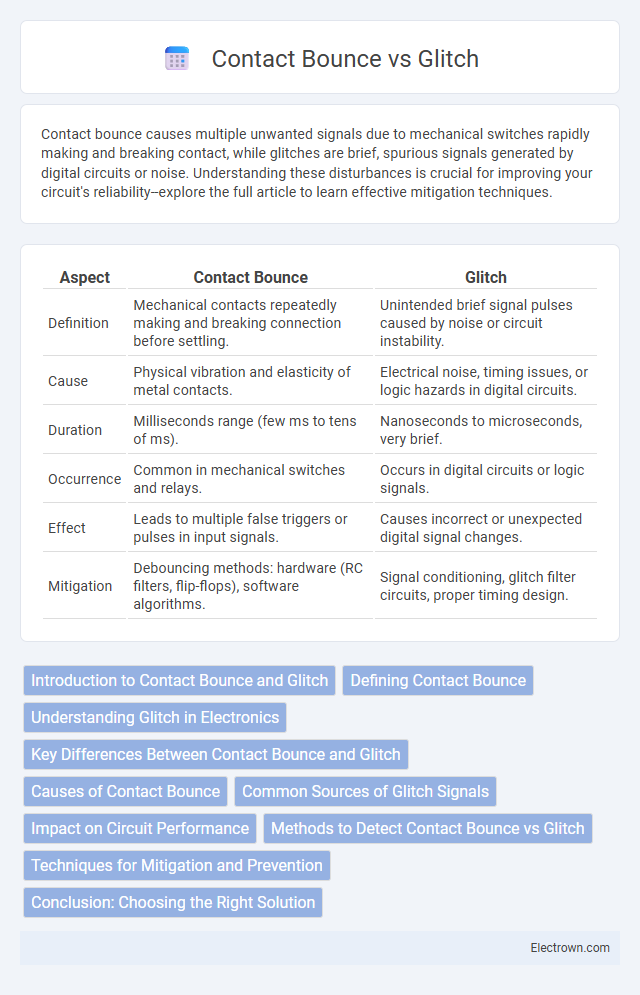Contact bounce causes multiple unwanted signals due to mechanical switches rapidly making and breaking contact, while glitches are brief, spurious signals generated by digital circuits or noise. Understanding these disturbances is crucial for improving your circuit's reliability--explore the full article to learn effective mitigation techniques.
Table of Comparison
| Aspect | Contact Bounce | Glitch |
|---|---|---|
| Definition | Mechanical contacts repeatedly making and breaking connection before settling. | Unintended brief signal pulses caused by noise or circuit instability. |
| Cause | Physical vibration and elasticity of metal contacts. | Electrical noise, timing issues, or logic hazards in digital circuits. |
| Duration | Milliseconds range (few ms to tens of ms). | Nanoseconds to microseconds, very brief. |
| Occurrence | Common in mechanical switches and relays. | Occurs in digital circuits or logic signals. |
| Effect | Leads to multiple false triggers or pulses in input signals. | Causes incorrect or unexpected digital signal changes. |
| Mitigation | Debouncing methods: hardware (RC filters, flip-flops), software algorithms. | Signal conditioning, glitch filter circuits, proper timing design. |
Introduction to Contact Bounce and Glitch
Contact bounce refers to the rapid, unintended oscillations or vibrations in a mechanical switch or relay's contacts when they close or open, causing multiple transient signals. Glitch is a brief, unwanted disturbance or spike in a digital signal, often resulting from timing errors or noise during signal transitions. Understanding these phenomena is crucial for designing reliable electronic circuits and ensuring Your digital systems operate smoothly without false triggering or errors.
Defining Contact Bounce
Contact bounce occurs when mechanical switch contacts rapidly open and close multiple times before settling, causing multiple unwanted signals. This phenomenon is common in relays, push-buttons, and mechanical switches, leading to erroneous digital inputs. Understanding contact bounce is essential for designing effective debounce circuits and ensuring signal integrity in electronic systems.
Understanding Glitch in Electronics
Glitch in electronics refers to a brief, unintended spike or disturbance in a signal caused by rapid switching or interference, distinct from contact bounce that occurs in mechanical switches. These glitches can lead to erroneous data processing in digital circuits if not properly filtered or debounced. Understanding glitch characteristics enables engineers to implement effective mitigation techniques such as Schmitt triggers or glitch filters, ensuring signal integrity and reliable electronic performance.
Key Differences Between Contact Bounce and Glitch
Contact bounce occurs when mechanical switches physically make and break contact multiple times before settling, causing multiple unintended signals. Glitches are brief, unintended voltage spikes or signal irregularities typically caused by noise or timing errors in digital circuits rather than mechanical movement. Understanding these key differences helps you diagnose signal integrity issues accurately in electronic systems.
Causes of Contact Bounce
Contact bounce occurs when mechanical switches or relays physically close or open, causing multiple rapid makes and breaks in the electrical connection due to the contacts physically bouncing off each other. This phenomenon results from the elasticity and mechanical imperfections of the switch materials, leading to transient, unwanted noise in the signal. Unlike glitches caused by electronic noise or circuit timing issues, contact bounce is inherently linked to the physical properties and mechanical motion of the switching components.
Common Sources of Glitch Signals
Glitch signals commonly originate from rapid switching in digital circuits, electromagnetic interference, and signal reflections causing unintended pulses. Contact bounce, on the other hand, occurs specifically in mechanical switches where the contacts physically oscillate before settling. Understanding these sources helps design robust debounce and noise filtering techniques in embedded systems.
Impact on Circuit Performance
Contact bounce generates multiple rapid on-off signals when a mechanical switch closes, causing false triggering and timing errors in circuits. In contrast, glitches are brief unintended voltage spikes or pulses caused by circuit design flaws or signal interference, leading to transient faults and logic errors. Both phenomena degrade circuit performance by increasing noise, reducing signal reliability, and necessitating additional filtering or debouncing measures to maintain system stability.
Methods to Detect Contact Bounce vs Glitch
Contact bounce can be detected using hardware debounce circuits such as RC filters, Schmitt triggers, or dedicated debounce ICs that smooth the signal transitions. Glitch detection relies on digital filtering techniques including synchronous sampling and logic analyzers capable of capturing rapid signal changes and short pulses. Your choice of method depends on whether you need to address mechanical switch noise or transient signal irregularities in digital circuits.
Techniques for Mitigation and Prevention
Contact bounce and glitch issues often disrupt signal integrity in digital circuits, making techniques like hardware debouncing and software filtering essential for reliable performance. Using RC low-pass filters, Schmitt triggers, or microcontroller-based algorithms can effectively reduce contact bounce by smoothing out transient fluctuations. Designing your system with these mitigation methods ensures stable input signals and prevents erroneous triggering caused by glitches or mechanical contact noise.
Conclusion: Choosing the Right Solution
Contact bounce and glitches both cause unwanted signal disruptions, but they arise from different physical phenomena requiring distinct mitigation methods. Selecting the right solution depends on your system's sensitivity and speed requirements; debouncing circuits or software algorithms effectively filter contact bounce, while glitch filtering and signal conditioning address digital switching errors. Understanding the specific source of noise allows you to optimize reliability and performance in your electronic design.
Contact Bounce vs Glitch Infographic

 electrown.com
electrown.com